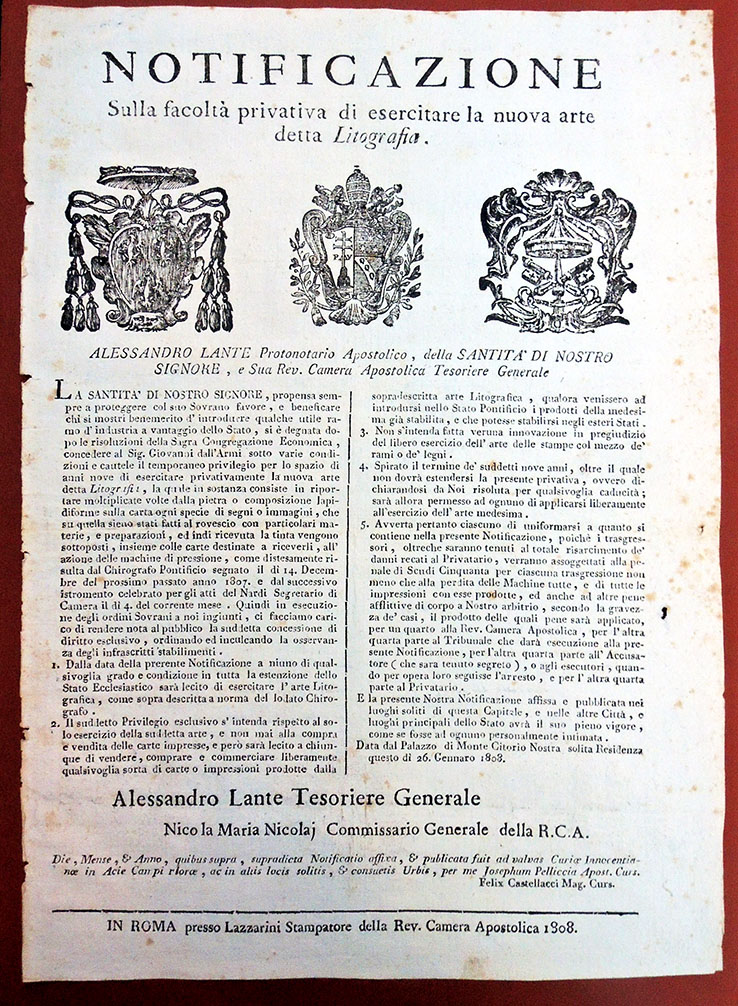Alessandro Lante and Nicola Maria Nicolaj. Notificazione sulla facolta privativa di esercitare la nuova arte detta litografia [Notification on the private faculty to practice the new art called lithography]. In Roma, presso Lazarini, stampatore delle rev. Camera Apostolica 1808. Folio (405 x 290 mm) broadside. Graphic Arts Collection GAX 2019- in process
The Graphic Arts Collection recently acquired this rare broadside published by the authorities of the Vatican State granting a one year privilege to the publisher Giovanni dall’Armi (died 1829) on the exclusive use of lithography as a printing technique on the territory of the Vatican State. This is followed by a concise description of its specification:
La nuova arte detta litografia, (…) consiste in riportare moltiplicate volte dalla pierra o composizione lapidiforme sulla carta ognie specie di segni o immagini, che su quella sieno stati fatti al rovescio con particolari materie, e preparazioni, ed indiricevuta la tinta vengono sottoposti insieme colle carte destinate a rice verli, all’azione della machine di pressione, come distesamente risulta dal Chirografo Pontificio segnato il di 14. Decembre del prossimo passato anno 1807.
This ephemeral document was printed twelve years before the first Italian manual on lithography was published in Florence: Cosimo Ridolfi (1794-1865) and Ferdinando Tartini, Memoria sulla litografia di C. Ridolfi, e F. Tartini (Firenze: Presso Gaspero Ricci, 1819).
In 1905, Giuseppe Fumagalli wrote in Lexicon typographicum Italiae:
Les origines de la lithographie à Rome qui étaient fort obscures, ont été éclaircies par les heureuses trouvailles de mon ami, le Dr. A. Bertarelli, bibliophile aussi savant qu’infatigable dans la chasse aux vieux bouquins, aux anciennes paperasses. Dans la préface du Trattato di lilografia, traduit du français et publié à Milan en 1828, il est dit que la lithographie existait à Rome dès 1807; mais il y a là une erreur grossière. L’introduction à Rome de cet art nouveau est due à Jean Dall’armi, que quelques-uns considèrent à tort comme l’introducteur de la lithographie aussi à Milan et à Venise où, probablement, il n’a jamais été ; et malgré son nom italien, les uns affirment qu’il était de Munich, les autres le croient français: il est probable qu’il était tout simplement italien. Les journaux romains de l’époque nous apprennent seulement qu’il est mort à Rome le 15 décembre 1829, et ces mêmes journaux, en donnant l’annonce de sa mort, confirment qu’il a été le premier fondateur à Rome d’une imprimerie lithographique.
Loosely translated:
The origins of lithography in Rome, which were very obscure, were cleared up by the happy discoveries of my friend, Dr. A. Bertarelli, bibliophile as learned as tireless in the hunt for old books, old paperwork. In the preface to Trattato di lilografia, translated from French and published in Milan in 1828, it is said that lithography existed in Rome as early as 1807; but there is a gross error. The introduction to Rome of this new art is due to Jean Dall’armi, whom some mistakenly consider as the introducer of lithography also in Milan and Venice, where, probably, he has never been; and despite his Italian name, some say he was from Munich, the others think he’s French: he’s probably just Italian. The Roman newspapers of the time only teach us that he died in Rome on December 15, 1829, and these same newspapers, in announcing his death, confirm that he was the first founder in Rome of lithographic printing.


